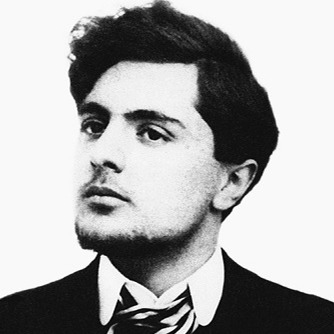
Amedeo Modigliani
The Italian painter Amadeo Modigliani, one of the most celebrated artists of the twentieth century, revitalized two enduring themes in art history: the portrait and the nude. He is best known for his distinctive style, featuring elongated figures and mask-like faces.
Biography of Amedeo Modigliani
Born as the fourth child into a Jewish family that declared bankruptcy just before his birth, Amedeo Modigliani had a special connection with his mother, who played a crucial role in enabling his pursuit of art. Devoted to drawing and painting from an early age, he considered himself an artist even before embarking on formal studies. Diagnosed with tuberculosis in 1901, the artist and his mother embarked on a recovery trip, visiting museums in Naples, Rome, Florence, and Venice, immersing themselves in classical art.
Two years later, Modigliani relocated to Florence to study figure drawing at Scuola Libera di Nudo and later to Venice, where he attended the Instituto di Belle Arti. It was in Venice that he first experienced the allure of life influenced by drugs and alcohol, inspiring him to make the move to Paris.
Residing in Paris, the artistic hub of the era, Modigliani extensively delved into the darker aspects of the metropolis, frequently consuming absinthe, smoking hashish, and engaging in numerous affairs with women. Despite deliberately cultivating disorderly and problematic life conditions, Modigliani was a prolific artist. Sometimes producing up to 100 drawings in a day, many of his works were lost or destroyed during bouts of madness.
In 1906, Modigliani joined the artistic community in Montmartre, displaying influences from already acknowledged artists such as Paul Cezanne and Henri de Toulouse-Lautrec. Rejecting conventional artistic norms, his style evolved into a blend of his earlier traditional knowledge and the influences of Pablo Picasso, Juan Gris, and poet Max Jacob.
Despite his commitment, a 1906 exhibition featuring three paintings at the Laura Wylda Gallery failed to attract buyers or generate interest in Modigliani's work. Forced to approach galleries door-to-door, he sometimes exchanged his pieces for food. This setback led him further into the realm of drugs and alcohol, exacerbating his health issues.
After receiving little attention at the twenty-fourth Salon des Independants, he decided to shift his focus to sculpture. The straightforward elegance and purity of form in his sculptural works reveal influences from primitive arts and a strong impression of Constantin Brancusi's work.
In 1914, Max Jacob eased Modigliani's challenges by introducing him to art dealer Paul Guillaume, who had already sold several of Modigliani's paintings and agreed to promote his art. However, World War I brought new difficulties, and the artist's fragile health deteriorated again. Despite the circumstances, he produced some of his finest works during this period.
Returning to portrait painting, Modigliani incorporated bold lines and geometric abstraction from his sculptures. His collaboration with Polish poet and art dealer Leopold Zborowski resulted in his first and only solo exhibition during his lifetime. Held at Berthe Weill Gallery in late 1917, the exhibition showcased 30 female nudes in his new, original style. To attract attention, one of the paintings was displayed in the front window, provoking the local police to close the exhibition. However, the unintended publicity led to unexpectedly improved sales.
Several months earlier, he encountered a young art student, Jeanne Hebuterne, who eventually became his wife and primary source of inspiration for the remainder of his life. The portraits of his newfound muse exhibited gentler lines and a brighter palette, mirroring a more serene state of mind. The following year, they welcomed a daughter named after her mother.
Honoring his agreement with Zborowski, Modigliani's productivity increased, and he gained greater confidence in his work. However, his health was unmistakably deteriorating, leading to his death from tubercular meningitis in 1920 at the age of 35. Holding him in her arms until the last moment, Hebuterne couldn't come to terms with the reality. Despite being nine months pregnant, she tragically threw herself from the fifth floor of their Parisian apartment, ending her own life along with their unborn child.
Years:
Born in 1884
Country:
Italy, Livorno
Gallery: